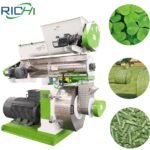A 10 tons per hour (t/h) pet feed mill represents a significant investment in the pet food industry. The choice and management of sales channels play a crucial role in determining the mill’s sales revenue and overall success. This article explores how different sales channels can impact the sales revenue of a 10t/h pet feed mill and strategies to optimize these channels for maximum profitability.Understanding the Production CapacityBefore delving into sales channels, it’s important to understand the production capacity of a 10t/h pet feed mill:
- Hourly capacity: 10 tons
- Daily capacity (16-hour operation): 160 tons
- Annual capacity (300 working days): 48,000 tons
This substantial production capacity requires efficient sales channels to ensure consistent demand and revenue generation.Key Sales Channels for Pet Feed
- Direct Sales to Pet Food Brands
- Retail Pet Stores
- Veterinary Clinics and Animal Hospitals
- E-commerce Platforms
- Wholesale Distributors
- Pet Boarding and Grooming Facilities
- Private Label Manufacturing
Impact of Sales Channels on Revenue
- Direct Sales to Pet Food Brands
Direct sales to established pet food brands can provide a stable and high-volume revenue stream. This channel often involves long-term contracts and bulk orders.Revenue Impact:
- High volume sales lead to consistent revenue
- Potential for lower profit margins due to bulk pricing
- Reduced marketing and distribution costs
Strategy:
Develop strong relationships with pet food brands by offering consistent quality, competitive pricing, and reliable supply.
- Retail Pet Stores
Selling through retail pet stores provides access to a wide consumer base and enhances brand visibility.Revenue Impact:
- Higher profit margins compared to bulk sales
- Increased brand exposure leading to potential growth in market share
- Revenue may fluctuate based on store performance and consumer trends
Strategy:
Offer attractive packaging, point-of-sale materials, and promotional support to drive sales in retail environments.
- Veterinary Clinics and Animal Hospitals
This channel provides credibility and can be particularly effective for specialized or prescription pet foods.Revenue Impact:
- Potential for premium pricing due to professional endorsement
- Lower volume sales but higher profit margins
- Steady revenue stream from repeat prescriptions
Strategy:
Develop relationships with veterinarians through educational programs and by demonstrating the nutritional benefits of your products.
- E-commerce Platforms
Online sales channels offer wide reach and convenience for consumers.Revenue Impact:
- Potential for rapid sales growth and market expansion
- Higher profit margins due to reduced intermediary costs
- Revenue can be affected by online competition and marketing effectiveness
Strategy:
Invest in digital marketing, optimize product listings, and ensure efficient fulfillment to maximize online sales potential.
- Wholesale Distributors
Distributors can help reach a broader market, especially in regions where direct distribution is challenging.Revenue Impact:
- Expanded market reach leading to increased sales volume
- Lower profit margins due to distributor commissions
- More stable revenue through diversified market presence
Strategy:
Choose distributors with strong networks and provide them with comprehensive product training and marketing support.
- Pet Boarding and Grooming Facilities
These facilities can serve as both sales points and product endorsers.Revenue Impact:
- Moderate sales volume but potential for high customer loyalty
- Opportunity for premium pricing through professional recommendation
- Revenue growth through word-of-mouth referrals
Strategy:
Offer special programs or incentives for facilities that promote and use your pet feed products.
- Private Label Manufacturing
Producing pet feed for other brands can utilize excess production capacity and provide additional revenue streams.Revenue Impact:
- Increased overall sales volume and capacity utilization
- Potentially lower profit margins but with reduced marketing costs
- Stable revenue through long-term manufacturing contracts
Strategy:
Maintain high quality standards and offer competitive pricing to attract and retain private label clients.Optimizing Sales Channels for Maximum Revenue
- Diversification
Utilize a mix of sales channels to reduce risk and maximize market reach. This approach helps balance high-volume, lower-margin sales with lower-volume, higher-margin opportunities. - Channel-Specific Pricing Strategies
Implement different pricing strategies for each channel to optimize profitability while remaining competitive. For example, offer volume discounts for direct sales to brands while maintaining premium pricing for specialized veterinary products. - Quality Control and Brand Consistency
Maintain consistent quality across all channels to build brand reputation and customer loyalty, which can lead to increased sales and potentially higher pricing power. - Tailored Marketing Approaches
Develop marketing strategies specific to each channel. For instance, focus on educational content for veterinary channels and engaging social media campaigns for e-commerce platforms. - Efficient Supply Chain Management
Optimize the supply chain to ensure timely and cost-effective distribution across all channels, which can improve margins and customer satisfaction. - Data-Driven Decision Making
Utilize sales data from different channels to inform product development, pricing strategies, and marketing efforts. This can help in identifying high-potential channels and products. - Customer Relationship Management
Invest in strong customer relationship management across all channels to encourage repeat business and referrals. - Continuous Innovation
Regularly introduce new or improved products to maintain interest across all sales channels and potentially command premium pricing.
Related post: pet food production line price
Conclusion
The choice and management of sales channels significantly impact the sales revenue of a 10t/h pet feed mill. A multi-channel approach, tailored to the strengths of each channel, can maximize revenue potential and market penetration. By carefully balancing direct sales, retail presence, professional endorsements, e-commerce, and private label opportunities, a pet feed mill can create a robust and diversified revenue stream.
The key to success lies in understanding the unique characteristics of each channel and adapting strategies accordingly. This includes tailoring product offerings, pricing, marketing approaches, and distribution methods to suit each channel’s requirements and customer base.
Furthermore, continuous monitoring and analysis of channel performance allow for agile adjustments to the sales strategy, ensuring optimal revenue generation. By effectively leveraging a mix of sales channels, a 10t/h pet feed mill can not only maximize its sales revenue but also build a strong, resilient market presence in the competitive pet food industry.
For details please contact: Richi Machinery
WhatsApp:86 138 3838 9622
Email:enquiry@richipelletmachine.com


